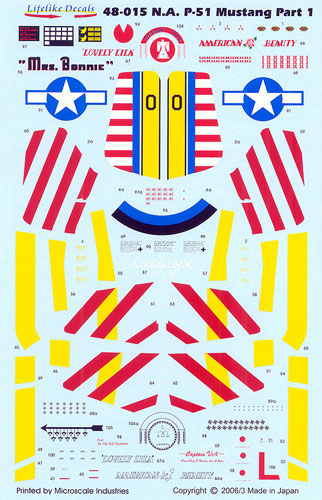|
S u m m a r y
|
| Catalogue
Number: |
48-015 - North American P-51
Mustang Part One |
| Scale: |
1/48 |
| Contents and Media: |
1 x A5
sized decal sheet; 1 x full colour double-sided A-4 instruction
sheet; 1 x single-sided A5 sized stencil placement guide |
| Price: |
Unknown at this time |
| Review Type: |
FirstLook |
| Advantages: |
Colourful and interesting
subjects; well printed and in register;
detailed stencil data supplied; |
| Disadvantages: |
|
| Recommendation: |
Recommended. |

HyperScale is proudly supported by
Squadron
Reviewed
by
Rodger Kelly
New from the
Japanese-based Lifelike Decals company is sheet 48-015 devoted to
the evergreen North American Aviation produced P-51 Mustang.
The sheet
provides markings for four machines that operated
in three different theatres in the final years of WWII.
 The
individual aircraft are: The
individual aircraft are:
-
P-51D-15-NA 44-15459 "AMERICAN BEAUTY"
flown by Captain John Voll of the 308th Fighter Squadron, 31st
Fighter Group when it was based at San Servo, Italy in late
November of 1944. The aircraft is in basic natural metal finish
with an olive drab anti-glare panel and is colourfully marked
indeed with a red nose and spinner, diagonal red stripes to her
vertical and horizontal stabilisers and yellow theatre bands on
her wings and horizontal stabiliser. Thankfully, you have been
saved from a lot of masking as all of the yellow bands are
supplied as decals as are the red stripes for her tail feathers.
-
P-51D-10-NA 44-14733 "Daddy's Girl"
flown by Captain Raymond Wetmore of the 370th Fighter Squadron,
359th Fighter Group, at East Wretham, in the UK between February
and March of 1945. The machine is in basic natural metal finish
with black theatre bands on her vertical stabiliser/rudder,
horizontal stabilisers and wings as well as an olive drab
anti-glare panel. Belonging to the 359th Fighter Group, she
wears their green nose group marking as well as the 370th
Fighter Squadron's blue rudder.
-
P-51D-10NA 44-14570 "Thunder Bird" of
the 335th Fighter Squadron, 4th Fighter Group, Debden, UK
between September and November 1944. Natural metal finish/olive
drab anti-glare panel again with black theatre bands and the 4th
Fighter Group's red nose group marking and the remains of the
6th of June 'D' Day black and white markings to her lower
fuselage.
-
A Pacific-based machine rounds out the
sheet. P-51K-10 44-12017 "Mrs Bonnie" flown by
Lieutenant Colonel Bill "Bull" Dunham, at that time, the Deputy
Commander of the 348th Fighter Group, Le Shima/Okinawa in August
of 1945. Finish is the basic overall natural metal/olive drab
anti-glare panel. Another colourful bird, she wears the Pacific
Theatre's thick black bands to her wings and fuselage as well as
a red and white striped rudder and yellow vertical stripe to her
fin (341st Fighter Squadron marking). Her spinner is finished
with a red tip, and yellow, blue and black bands representing
the colours of each of the four squadrons that made up the
Group. Having struggled in trying to paint bands on spinners in
the past, I was happy to see that Lifelike has supplied each of
the bands (less the black one) as a decal. A pair of faded
fuselage national insignia is provided too but they look a tad
too faded for my liking!). If you are lucky enough to have the
Ethel and Bodie book "War Eagles in Original Colour", it
features a beautiful colour photograph of this machine on page
12.
Click the thumbnails below to view
larger images:
A hallmark of
Lifelike Decals is the comprehensive research they undertake in
producing their decals. This sheet is no exception and lists 20
different references they have consulted in bringing it to
fruition. The resulting research is documented on the placement
guide and where there is any controversy or doubt as to what
markings were worn on the one-to-one-scale machines; a full
explanation as to why they chose to depict the marking as they have
is given.
The placement guide
itself is A-4 in size, and printed on very thin cardboard. It
provides left hand side profiles for each option as well as a scrap
view of the right hand side of the nose of the first option and a
close-up of the nose marking of the third option. Also included is
the descriptions/history of each option on the centre pages and
appropriate upper and lower surface views on the back page (with the
exception of the second option!) A full list of the references
consulted is also provided.
There are two
sheets provided in this issue. The larger one carries the vast
majority of the markings whilst the smaller one carries a single set
of national insignia, black (European only) theatre bands, squadron
and plane in squadron code letters and comprehensive stencil data.
Amongst this stencil data, is a separate and correct data block for
each option as well as both Aero Products and Hamilton Standard
propeller logos (the Hamilton Standard ones have a separate white
background!)
The decals
themselves have been printed by Microscale. They are thin, have a
minimum of film surrounding each subject and are in perfect
register. Where it was likely that there was going to be problem
with register, Lifelike has provided two-part decals, examples of
these include the black surrounds to the names of the first option,
and the black portions of the nose art for the third option.
The placement guide
and the two decal sheets come packed in a clear plastic zip-loc
bag.
A very nice sheet
from Lifelike Decals. Hopefully, they will produce more P-51
sheets in the future!
Recommended.
Thanks to Keishiro Nagao of Lifelike Decals for the
review sample.
Lifelike
Decals are available by email at
lifelike@eos.ocn.ne.jp or
from
2-8-7-202, Kameari,
Katsushika, Tokyo 125-0061, Japan
fax: +81-3-5680-6733 |
Home | What's
New | Features
| Gallery |
Reviews | Reference
| Forum
| Search